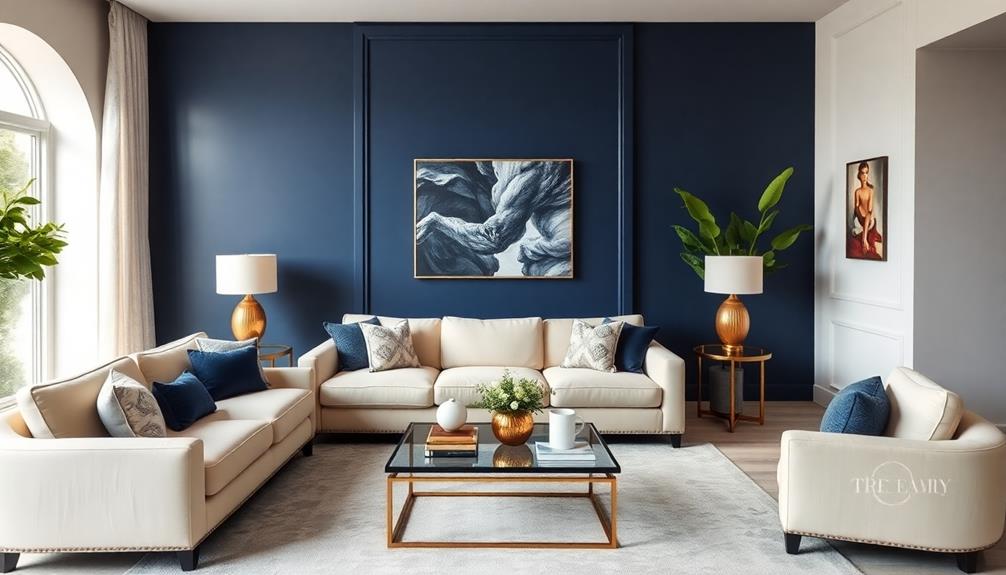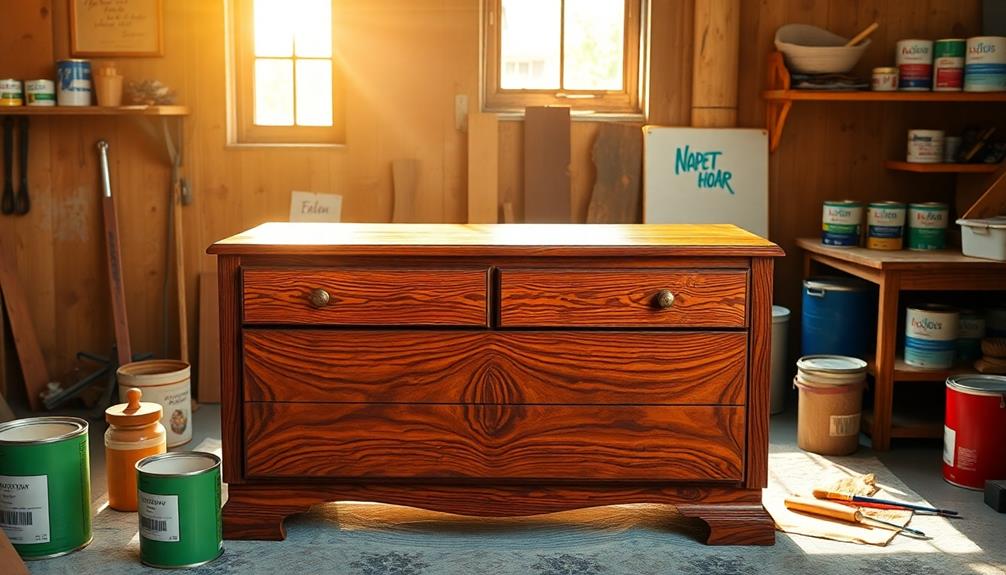Navy blue accent walls can dramatically transform your space, adding depth and sophistication. You can create a coastal vibe with rope accents and nautical decor, or make a bold statement that draws attention in living or dining areas. In bedrooms, this color fosters a cozy, intimate atmosphere, pairing beautifully with light furnishings. For modern kitchens, consider navy cabinets or backsplashes that redefine your design. Whether for a home office or a stylish dining room, navy blue enriches any space. Want to discover more tips on how to maximize this color's potential? You might find some exciting ideas ahead.
Key Takeaways
- Navy blue accent walls create a stunning focal point, enhancing the sophistication of any room.
- Pair navy with lighter furnishings to achieve a striking contrast that elevates the ambiance.
- Incorporate metallic accents and plush fabrics to add a touch of glamour and luxury.
- Use complementary artwork and decor to enhance visual interest and cohesion in your space.
- A navy blue accent wall can transform cozy bedrooms, elegant living areas, or stylish dining rooms, adapting to various styles.
Coastal and Nautical Themes

Creating a coastal and nautical theme with navy blue accent walls brings the serene beauty of the seaside into your home. You can enhance this vibe by incorporating rope accents and anchor decor, which evoke the charm of coastal living.
Add seashell motifs to your textiles and artwork, creating a cohesive look that feels fresh and inviting. Striped fabrics in white and navy will tie the room together beautifully.
Don't forget to introduce driftwood accents and beach-inspired artwork for character. Weathered wood furniture complements this aesthetic perfectly, while maritime lighting fixtures can illuminate your space with a warm glow.
Bold Statement Walls

Transforming your space with navy blue accent walls instantly makes a bold statement that captures attention. Pairing navy blue accent walls with sleek furnishings and metallic finishes elevates the overall aesthetic, creating a perfect blend of sophistication and contemporary charm. Integrating modern console decor ideas—such as minimalist vases, geometric sculptures, or statement mirrors—can enhance the visual appeal while maintaining a functional yet stylish vibe. This cohesive design effortlessly draws the eye and transforms any room into an inviting and chic sanctuary.
This deep hue creates a stunning focal point, perfect for entryways or dining rooms. With navy blue, you can elevate the sophistication of your home, drawing guests in with its rich color.
It sets an elegant ambiance, making gatherings feel more formal and inviting. Pair navy walls with lighter furnishings or metallic accents to enhance the drama and depth of the space.
Consider integrating artwork or decor that complements the navy, creating visual interest.
Whether you're hosting a dinner party or welcoming guests, a navy blue accent wall transforms your environment into a stylish haven that exudes confidence and charm.
Cozy and Elegant Bedrooms

Navy blue accent walls can elevate not just living areas but also your bedroom, adding a touch of elegance and sophistication.
This rich hue creates a cozy and intimate atmosphere, perfect for relaxation after a long day. Pair navy blue with white or light furniture to achieve a striking contrast that brightens the space.
Incorporate metallic accents, like gold or silver, to enhance the luxury feel. Coordinate your bedding and curtains in complementary shades for a cohesive look that ties the room together beautifully.
With the right decor and accents, your navy blue bedroom can become a serene sanctuary, blending comfort and style seamlessly while making a bold statement.
Sophisticated Living Spaces

A sophisticated living space instantly captivates with its depth and character, especially when adorned with navy blue accents. This versatile color enhances your living room, creating a warm atmosphere perfect for both entertaining guests and relaxing after a long day.
Navy blue pairs beautifully with various décor styles, from contemporary to traditional, allowing you to express your unique taste. Consider incorporating plush fabrics and rich textures to further elevate the elegance. You can also add metallic accents for a touch of glamour, making your space feel more luxurious.
With navy blue as your foundation, you'll effortlessly achieve a chic and sophisticated environment that invites conversation and comfort, transforming your living area into a stylish haven.
Modern Kitchen Designs

Embracing a modern aesthetic, navy blue can redefine your kitchen space with its bold elegance. You can opt for striking navy blue cabinets that instantly elevate the room's design.
Pair these with sleek countertops and chic bar stools in complementary shades for a cohesive look. A bold navy backsplash adds a contemporary touch, enhancing the overall ambiance. This deep hue not only creates drama but also exudes sophistication, making your kitchen a standout feature of your home.
To balance the richness of navy blue, incorporate lighter elements, such as white dishware or light wood accents. This contrast will create a harmonious and inviting atmosphere, perfect for cooking, entertaining, or simply enjoying your space.
Stylish Dining Rooms

With navy blue as the focal point, your dining room can transform into a stylish and inviting space.
This bold color enhances the room's aesthetics, adding depth and character while creating a perfect backdrop for your dining table.
To elevate your dining experience, consider these three key elements:
- Metallic Accents: Incorporate gold or silver accessories to add a touch of glamour.
- Lighting: Use statement lighting fixtures that complement the navy walls, enhancing the ambiance.
- Textiles: Opt for chic table runners or seat cushions in contrasting colors to create visual interest.
Versatile Home Office Spaces

Creating a versatile home office space can greatly boost your productivity and focus. By incorporating a navy blue accent wall, you establish a calming backdrop that enhances your concentration.
Pair this deep hue with light-colored desks and shelving for a striking contrast that keeps the environment bright. Add gold accents through desk accessories or lighting fixtures to elevate the elegance of your workspace.
Consider incorporating functional elements like a corkboard or shelving that complements your navy theme while keeping everything organized.
You'll find that a well-designed home office not only looks great but also fosters creativity and efficiency. With these design tips, you'll transform your office into a stylish and productive haven.
Frequently Asked Questions
What Colors Pair Best With Navy Blue Accent Walls?
To enhance navy blue accent walls, pair them with crisp white or light gray for contrast. Gold or silver accents add elegance, while warm hues like coral create a lively balance. Experiment to find your perfect combination!
How Can I Maintain Navy Blue Walls Over Time?
To maintain your navy blue walls, regularly dust them with a soft cloth. For stains, gently wash with a mild soap solution. Avoid harsh chemicals, and consider reapplying paint every few years for a fresh look.
Are Navy Blue Accent Walls Suitable for Small Rooms?
You might think navy blue's too dark for small rooms, but it can actually create depth and a cozy feel. Just balance it with lighter colors and strategic lighting, and your space will shine beautifully.
What Finishes Work Well With Navy Blue Paint?
When choosing finishes for navy blue paint, consider light woods, metallic accents, or crisp whites. These combinations create contrast and enhance the elegance of your space, making it feel more inviting and stylish.
Can I Use Navy Blue in Unconventional Spaces?
Think of navy blue as a deep ocean, bringing depth to unconventional spaces. You can use it boldly in areas like kitchens or offices, creating a unique atmosphere that inspires creativity and calmness.
Conclusion
Incorporating navy blue accent walls can truly transform your space into a stunning sanctuary. Whether you're aiming for a coastal charm, a cozy retreat, or a sophisticated statement, this bold hue brings beauty and balance. With the right design choices, you'll create an enchanting atmosphere that complements your unique style. So, don't hesitate to plunge into the deep end of design—embrace navy blue and watch your home flourish into a fabulous haven of elegance!









